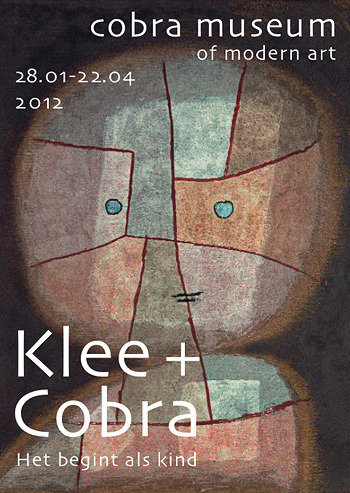Klee and Cobra
dal 27/1/2012 al 21/4/2012
Segnalato da
27/1/2012
Klee and Cobra
Cobra Museum, Amstelveen
A Child's Play. The exhibition reveals the shared fascination of Paul Klee and the Cobra artists with the wondrous, imaginary world of the child. Over 130 Paul Klee masterpieces and 120 by Cobra artists (Karel Appel, Constant, Corneille, Eugene Brands, Asger Jorn, Pierre Alechinsky and others) have been brought together from international collections.

The exhibition reveals the influence that Paul Klee (1879-1940) had on the Cobra movement (1948-1951), seen from the perspective of their shared fascination for the wondrous world of children's imagination. This theme has never before been so thoroughly investigated in an exhibition. In all, 120 masterpieces by Paul Klee (oil paintings, works on paper, mixed media works and sculptures) and about 100 highlights by the Cobra artists (Karel Appel, Constant, Corneille, Eugène Brands, Asger Jorn, Pierre Alechinsky and others) are being brought together from international collections. This offers visitors a unique opportunity to view the similarities and the differences between Klee and Cobra. This exhibition has been made possible with the support of the Turing Foundation, the Mondriaan Foundation, the Prins Bernhard Culture Foundation, SNS REAAL Funds and the Business Club of the Cobra Museum.
Klee en Cobra
In the spring of 1948, the Amsterdam Stedelijk Museum, under director Willem Sandberg, held a major exhibition of the work of Paul Klee, the first in the Netherlands. The press responded enthusiastically. Soon thereafter, the Stedelijk held the first exhibition of the CoBrA group, young, largely Dutch painters and poets. This time, the media was merciless: it was just messy blobs and worse; ‘My little boy can do that too’. The public, however, visited the exhibition in droves.
Exhibiting Paul Klee and Cobra together may not at first seem self-evident. The young Dutch Cobra artists only became fully acquainted with the work of Paul Klee in 1948, with the exhibition at the Stedelijk Museum. The Swiss artist had died eight years before. His work nonetheless made a great impression on both the Dutch and the non-Dutch Cobra artists.
The imaginary world of the child as a shared source of inspiration
Paul Klee and the Cobra artists all shared a genuine fascination for the liberating simplicity, the fantasy, the purity and the rich colour of children's drawings. As a boy, Klee had been fervently enthusiastic about drawing, and after rediscovering his own childhood drawings in 1902, he would refer back to them for the rest of his life. He also encouraged his son Felix, born in 1907, to draw. This exhibition includes original childhood drawings by both Paul and Felix Klee, which have never before been shown outside Switzerland.
The Cobra artists were equally enthusiastic about collecting children's drawings and regularly worked with children. Eugène Brands' daughter Eugénie was something of a muse for him, and the exhibition presents a number of handsome examples. The Cobra artists also identified with the principles and the childlike spontaneity of the work of Paul Klee. They worked in a similar way. The power of their work in the early Cobra years can be largely credited to an unpretentiousness and a directness that is often seen in children. This exhibition shows both the similarities and differences in working methods and ideas about the role and the meaning of the child, for both Klee and the Cobra artists. This is expressed in such themes as the imagination of the child, fantastic animals, masks and grotesque faces, acrobatics and aggression amongst children themselves. The Cobra artists' response to the work of Paul Klee is also revealed in detail.
International collaboration
Klee and Cobra has been organized by an international team of curators from museums in Switzerland, Denmark and the Netherlands: the Zentrum Paul Klee in Bern (where the exhibition was held from 25 May-4 September 2011), the Louisiana Museum of Modern Art in Humlebaek (30 September 2011-8 January 2012) and the Cobra Museum of Modern Art in Amstelveen (28 January-22 April 2012).
Important works have been made available on loan for this exhibition from museum collections, as well as a number of private collections. In addition to drawings made when Paul Klee was a child (aged four and six) and those of his son Felix, the exhibition gives an excellent overview of Klee's entire oeuvre, until and including 1940, the year he died. A number of large works painted on jute are exceptional: La belle jardinière and Love Song at New Moon, both from the Zentrum Paul Klee and painted by Klee in the 1930s, and Summer Landscape, from 1918, from the collection of the Triton Foundation. The 1949 oil painting, Hip, Hip, Hoorah!, by Karel Appel, from the collection of the Tate Gallery in London, and Asger Jorn's monumental canvas, Letter to my Son, painted in 1956-1957 (also in the Tate collection), are amongst the highlights of the exhibition.
Catalogue
The Dutch-language catalogue, Klee en Cobra. Het begint als kind, is published by Ludion. The English and German editions are published by Hatje Cantz Verlag. The catalogue is 224 pages, with 269 illustrations, 246 in full colour, available in paperback or hard cover.
Associated Programmes
The University of Amsterdam (UvA) will be collaborating with the Cobra Museum for research purposes during the exhibition, resulting in an extensive programme covering the psychology of children's drawings.
This programme has been made possible with the support of SNS REAAL Funds.
Children's Programme
Together with the Zabawas Foundation, a complete educational and creative programme for children is being developed.
Cobra Museum
Sandbergplein 1 - Amstelveen
Opening hours: Tuesday to Sunday 11.00 - 17.00
Admission: Adult 12,00 euro
Concessions: 5,00 euro



